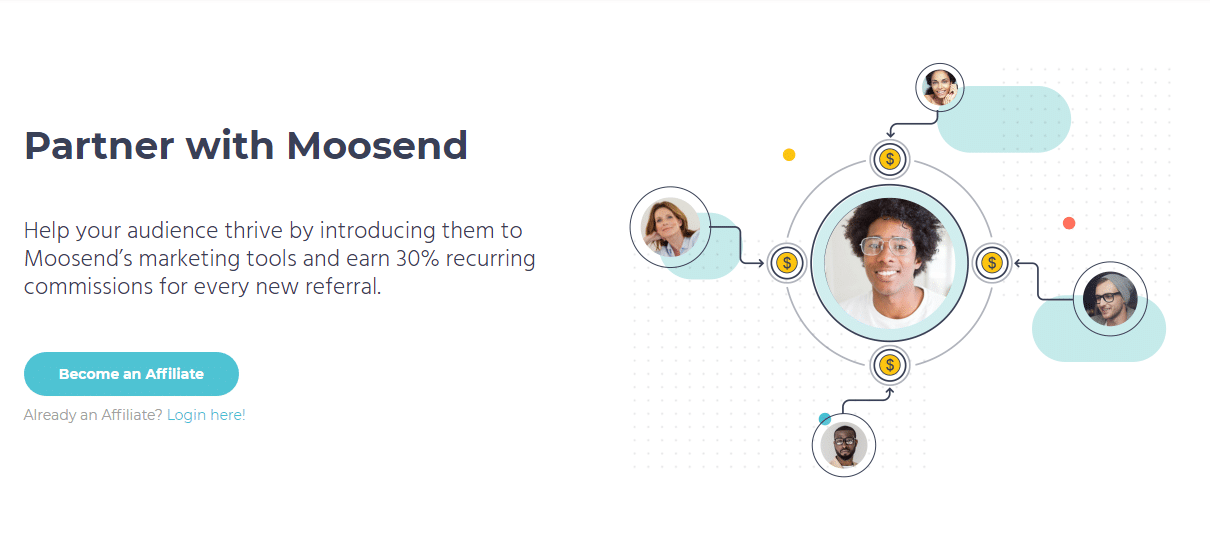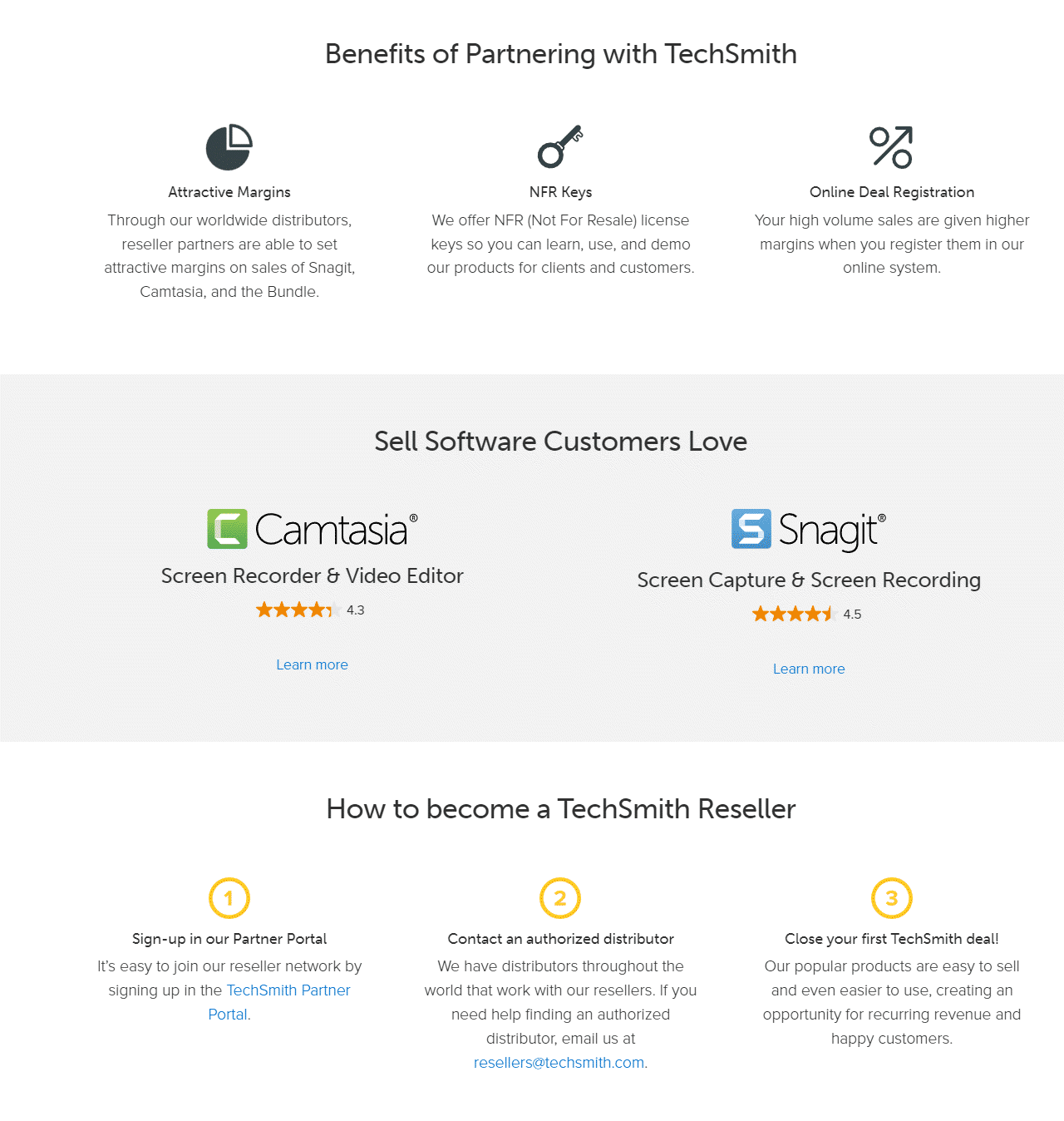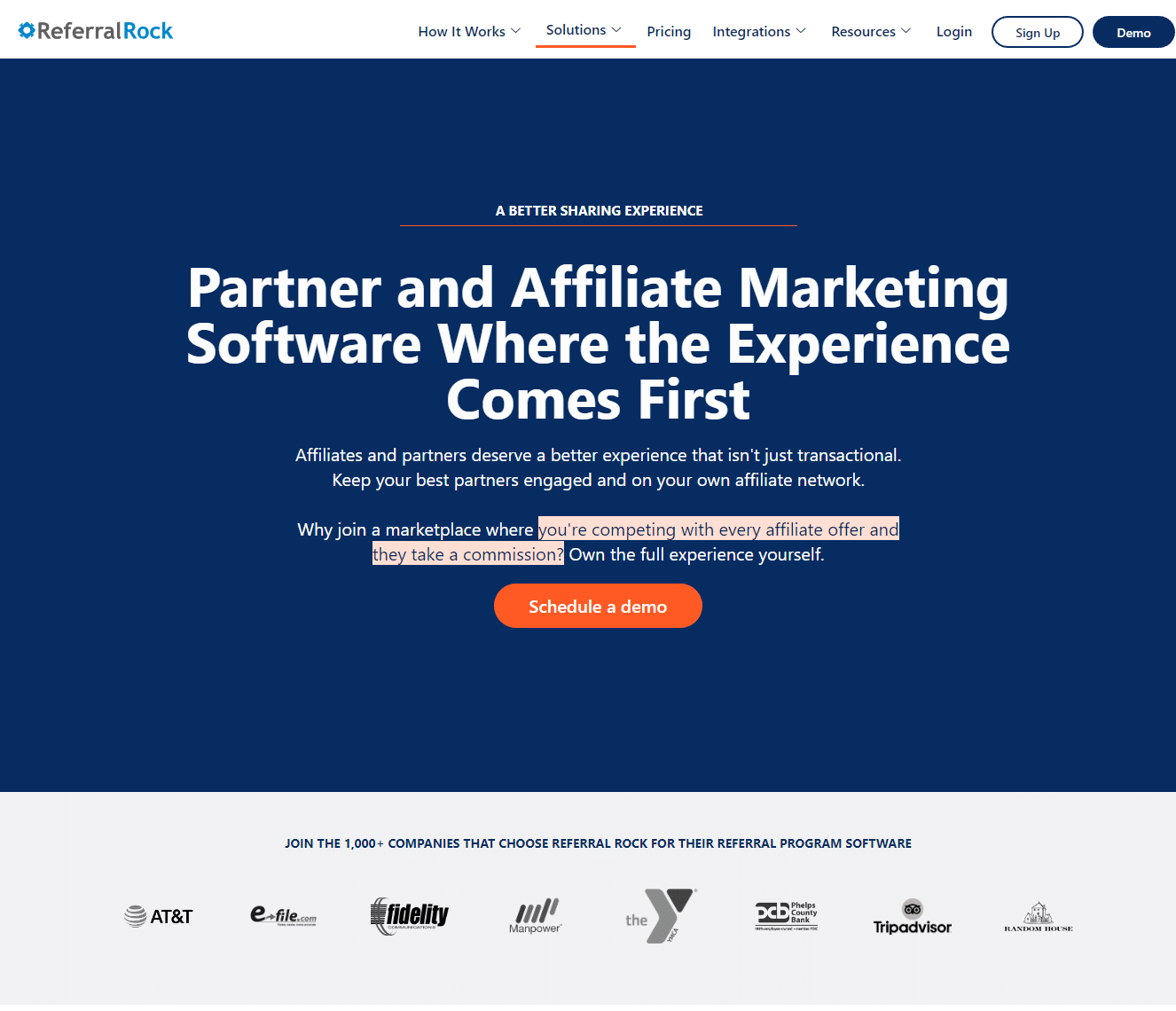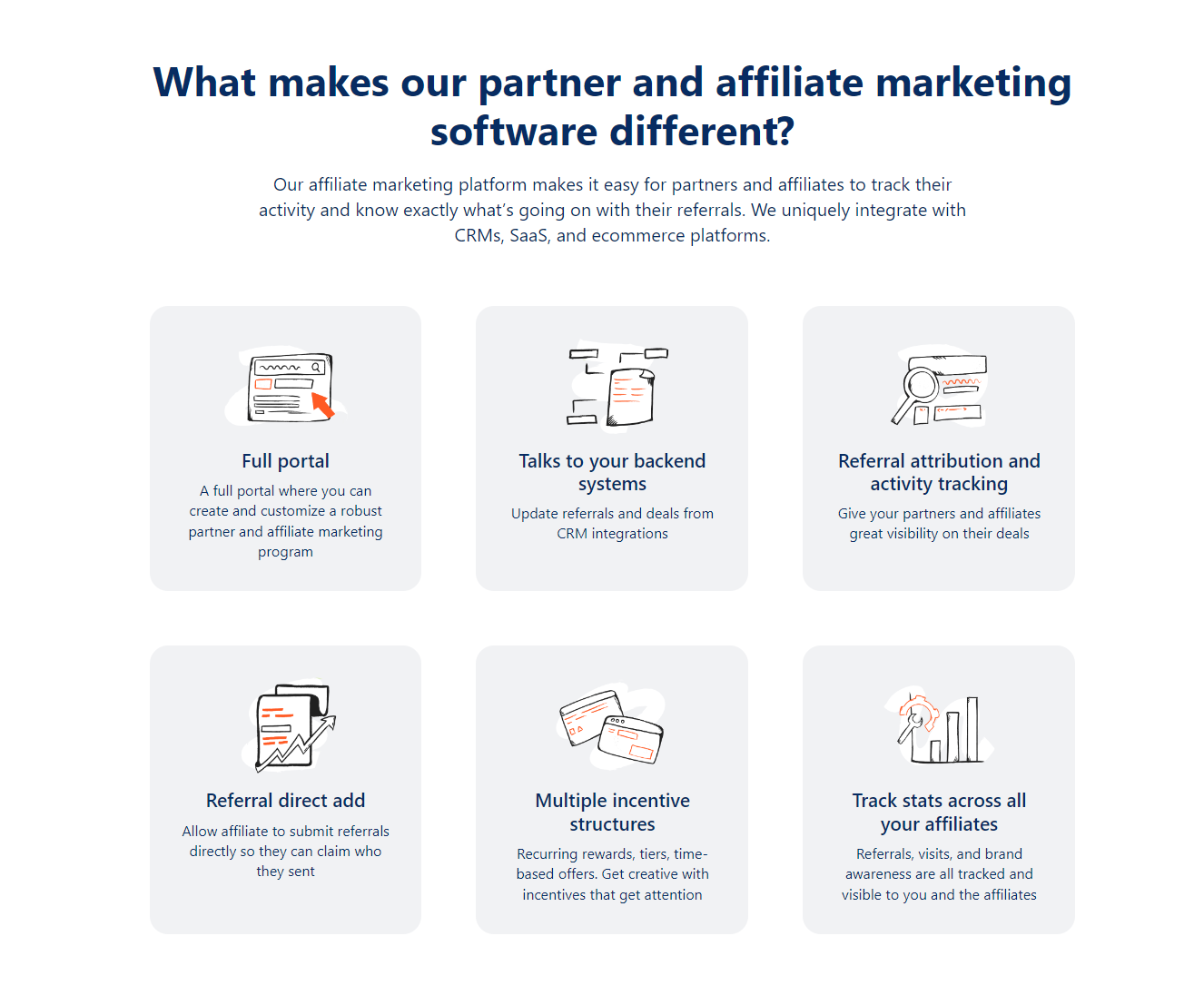The B2B sales cycle is a long and winding journey. You talk to multiple decision-makers and (hopefully) cultivate long-term relationships.
A B2B partner program helps smoothen the road. By partnering with another business, you gain an additional sales arm that recommends you to their audience.
Whether you’re a B2B SaaS, a consultancy-based B2B, or any other B2B company, a partnership can help both you and your partner reach goals that are difficult to accomplish on your own.
In this article, we walk you through what sets each type of B2B partner program apart and how to identify the best partners for you. We also include some of the best partnership advice to follow.
But first, let’s start by defining B2B partnerships and B2B partner programs.
What is a B2B partnership?
A B2B partnership is a mutually beneficial collaboration between two businesses, or between a business and an individual. It helps both parties grow and achieve value.
This partnership could be in the area of B2B marketing, sales, distribution, or a combination of business opportunities.
Notably, B2B partners remain independent from your business. They are not your employees, even though they – and you – enter into a formal partnership agreement.
What is a B2B partner program?
In a B2B partnership, a B2B company formally partners with another business or individual to create a mutually beneficial arrangement, one with significant value for both parties.
A B2B partner program is also known as a channel partnership. It is a structured way to incentivize these partners for helping you grow and accomplish goals.
The partner will promote and/or distribute your products to a new market segment. In turn, your business will reward the third party with commission or other incentive for helping your brand grow. The more your partner contributes to your growth, the bigger the rewards.
Usually, businesses will manage their channel partnerships with partner program software. Partner management software tracks each step of the partnership, organizes any marketing materials, distributes incentives, and monitors results.
Types of B2B partnership programs
“Partner program” is an umbrella term – there are actually several types of B2B partnerships.
Your B2B can leverage several types of B2B partner programs, including referral, affiliate, reseller, agent, and distribution partnerships. Each B2B partnership has the potential to increase your sales and scale your growth. But to reap these benefits, you need to select the partnership type (or types) that will best meet your business needs.
Some B2B channel partner programs involve partners directly buying your products for distribution. Others encourage partners to promote your business and direct leads to your website, without directly selling your products.
What all B2B partner programs have in common are a formal agreement and an incentive (although the incentive can vary in type, it’s not always monetary).
Here are the most common types of partnerships B2Bs use.
1. Affiliate partnerships
Affiliate partnerships are a type of sales and marketing partnership. In affiliate programs, you sign up third-party content creators to market your products through their own online channels. These channels can include blogs, email newsletters, and social media platforms.
For instance, if you are a B2B SaaS company, you could partner with a tech review blog to promote lead generation and get your software in front of a wider, relevand audience.
Each content creator you partner with places your affiliate links on their channels, which then direct their audience to your business website. Whenever a user clicks on that link and makes a purchase, you reward the affiliate with a cash commission.
Moosend’s affiliate partner program
2. Agent/broker partnerships
Agents (brokers) represent multiple B2B companies by building relationships with your target audience. While they market your products to these potential clients, they are not resellers.
Your B2B enters a formal partnership with the agent, and then rewards them when their connection leads other businesses to purchase from you.
A marketing agency hasn’t necessarily used your products or had any prior relationship with anyone they represent. They’re more like third-party “headhunters” who connect you with other businesses that may benefit from what you offer.
An agent partner program is excellent if you need to acquire more qualified leads but lack a larger in-house sales team.
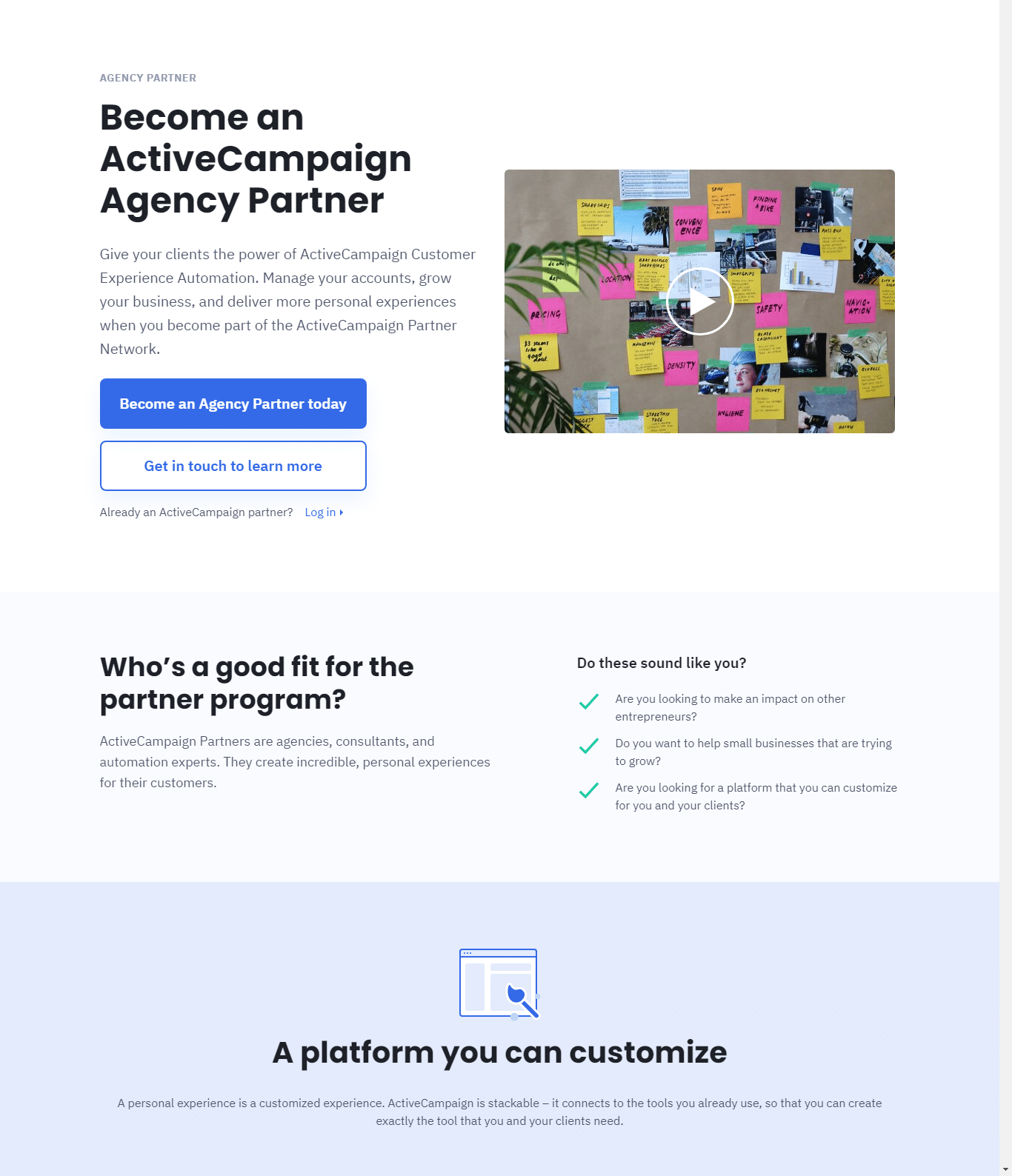
The ActiveCampaign agency partner program
3. Referral partnerships
Referral partners are existing customers who have used and loved your products or services at their own business. They could be businesses as a whole, or individuals at the businesses you serve.
In B2B referral partnerships, the partners only refer people or businesses they have a personal connection with.
This direct recommendation is the most powerful type of endorsement for your business because of the high level of trust involved.
Iconixx’s referral partner program
Even though a B2B referral partner won’t generate as many leads as, say, an affiliate marketing partnership, referrals bring in high-quality warm leads who are the most likely to purchase from you. This is invaluable for B2Bs with a long sales process.
B2B referral partnerships are similar to customer referral programs. But while B2B customer referral programs are open to all your clients, a referral partner program consists of handpicked partners. It also includes a more formalized process, where partners are trained on how to represent you and who would be a good fit to refer.
4. Reseller (retailer) partnerships
Resellers are partners with a direct license to sell your products in their store or on their own digital channels.
In the B2B sector, the most common reseller partnership is the software marketplace (SaaS marketplace). These resellers sell software programs from multiple publishers.
B2B SaaS resellers are also trained to assist the client in using the software they sell. They’re certified to help with setup, customization, and any other support needs. They’re similar to members of your customer support team, but they still remain independent third parties.

TechSmith’s software reseller partnership program
Our guide to SaaS partner programs covers tips and best practices specific to B2B SaaS partnerships, along with four detailed B2B SaaS partner program examples.
5. B2B wholesaler partnerships
A wholesaler buys your goods in large quantities and then sells them to other businesses, whether to a physical store or digital marketplace.
A B2B wholesaler is an excellent option if you need to tap into a large customer base that was previously hard to reach. Amazon Business is one well-known example of a B2B wholesale partnership. The platform allows business supply companies to sell their physical products to an audience of millions, and rapidly scale in the process.
6. Distributor partnerships
Compared to wholesalers, B2B distributors buy smaller quantities of your products and resell them to other businesses.
In most cases, distributors are key to getting your product in the hands of wholesalers or resellers, who in turn sell your B2B products to interested businesses. This helps widen your market reach.
Why start a B2B partner program?
Partner programs are an effective strategy to grow your brand and increase sales. But the benefits don’t end there.
All types of B2B partner programs can help your brand:
Expand to new markets and verticals that would be difficult to reach on your own: For instance, if you are trying to break into an international market, reseller and distributor partner programs will help you reach this goal faster.
Quickly increase brand awareness: B2B partner programs allow you to break into new market segments and audiences – audiences that are already pre-built for you, and that wouldn’t have heard of you without your partner’s help.
Scale your growth: With B2B partnership strategies, growth becomes easier thanks to expanding into your partner’s market audience and leveraging their authority. Your partner’s audience trusts their recommendation or endorsement of the partner, making them more likely to purchase.
Increase revenue in a cost-effective way: Partner programs are cost-effective because they are performance-based. You only pay when partners help you make a sale, whether it’s because they brought in the leads or directly bought your products for distribution.
Build relationships with like-minded partners. When you integrate your brand with your partner’s, it can improve your sales process in ways you couldn’t accomplish on your own. You’ll have access to peers who can collaborate to generate relevant ideas and achieve previously unreachable goals. And you’ll be able to cooperatively share each other’s resources.
Is a B2B partner program right for your business?
Not every B2B brand will be ready for a partnership program. If you want to establish an effective B2B partner program, be sure your business meets these criteria first:
- Your business is already established, and there’s a reasonable demand for your products or services.
- Your sales cycles are solidified, and you know what strategies work well for marketing your products (essential before you train a third party to market and/or sell your products for you)
- You have the capacity to accommodate more growth
- You’re willing and able to incentivize ideal partners for the sales they help you make
- You know the key markets or verticals you want to reach through B2B partnerships – ideally, ones that would be difficult to reach on your own
- You have specific goals in mind (for increasing customer base and revenue) that you want your partnerships to help you achieve
- You evaluated all the types of B2B partnerships available, and know which one(s) would best help you reach your business goals
How to find the right B2B partners?
Before launching a B2B partnership program, it’s critical to select partners who best fit your business needs.
Ask yourself these key questions when deciding who you want to partner with:
- What partners can help you access the new markets or verticals you’d like to enter?
- How widely do you want to increase distribution?
- If you’re a smaller B2B or new to partnerships, will you have enough financial resources to run a partnership?
- What amount of reach do you want each partner to have? Local? Regional? National?
- Should each partner have a minimum (or maximum) customer base or estimated audience?
- How do you want partners to distribute your product – online, in-store, or a hybrid of both?
- What unique advantages would a potential partnership bring you?
- How would distributing your product benefit your potential partner and their audience?
- What values does your company hold? And do these values match with your partner’s values?
- Is a potential partner ready and able to enter into a solid partnership?
- What don’t you want in a partner?
Once you’ve answered these questions, determine what partners will best fit your sales, marketing, and distribution needs:
-
- Affiliates: Targeted but very wide distribution; send leads to your website rather than reselling products
- Agents/brokers: Recommend your products to anyone who might be a good fit; send leads to your website rather than reselling products
- Referral partners: Customers who recommend your brand to colleagues they know; send leads to your website rather than reselling products
- Resellers: Sell your products in their own storefront
- Wholesalers: Purchase large quantities of your product all at once, then directly sell them to B2Bs
- Distributors: Purchase small quantities of your products and get them in a wholesaler’s or reseller’s hands
How do you create a B2B partnership?
Creating a B2B partnership involves finding and reaching out to the types of partners who will best meet your needs, and discussing mutual benefits of a potential partnership. Then, if you and your prospective partner agree to form a relationship, you’ll make things official with a partnership contract.
We’ll cover more details on establishing mutual partnership benefits, and creating a partnership agreement, below.
7 essential steps for running a B2B partner program
For your B2B partner relationships to bring in the desired results, you need to follow these best practices.
1. Reach out to your desired partners
A successful B2B partnership strategy starts with properly reaching out to the best-fit partners.
This first discussion should cover mutual goals, what you and your partner offer each other that you can’t achieve on your own, and what you’d like to accomplish together.
Finally, make sure to survey the new partners about any previous partnerships, benefits they seek from your partnership, and any challenges.
2. Offer valuable partner incentives
Channel partner incentives are vital in making partners feel appreciated and like part of your team, even though they remain independent from your business.
The incentives should be based on performance and scale. In other words, they need to increase in value as partners distribute or sell more of your products/services.
Some B2B incentives to offer include:
- Percentage commissions on each sale made
- Flat commissions on each sale made
- Wholesale discounts
- Sales performance incentive funds (SPIF): These are incentives, such as a trip, gift card, or valuable tech item, that go directly to a salesperson when they meet time-based sales goals
- Co-op funds: Cash incentives for distributing and reselling products
- Market development funds (MDF): Cash that goes to the partner’s business, to help it accomplish future sales and marketing goals
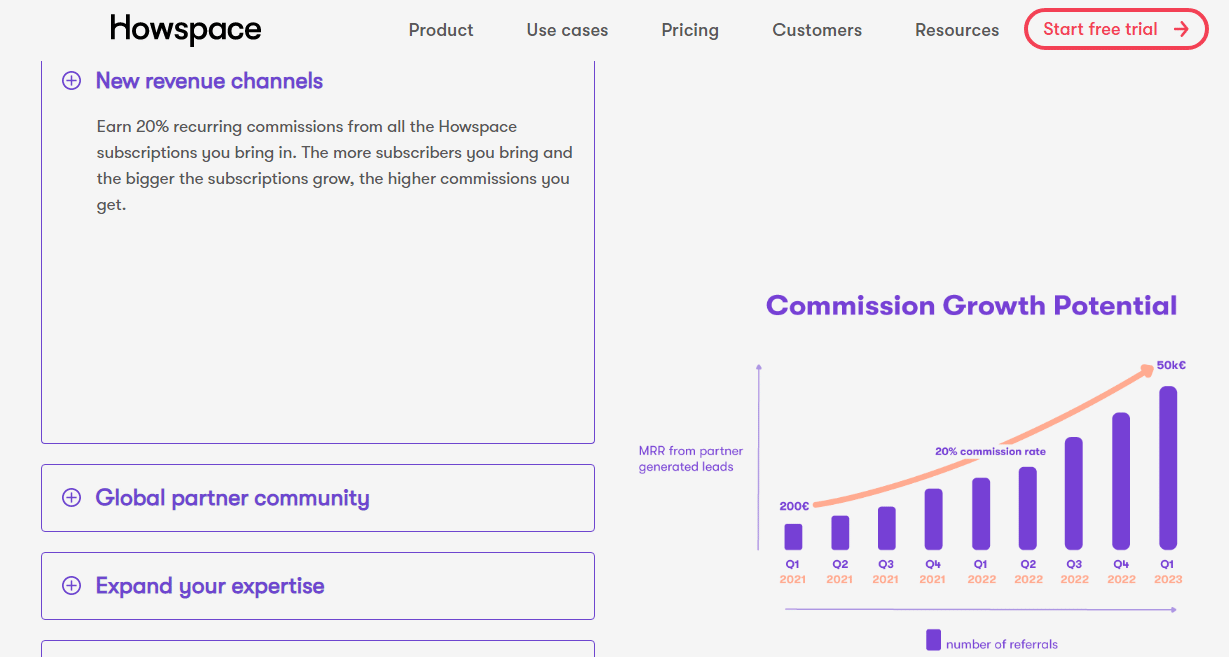
Howspace’s partner program awards their affiliate partners with recurring commissions when subscribers they bring in renew their subscription.
Take it a notch higher and reward partners with the following incentives:
- Exclusive partner events
- Free webinars or educational sessions for business development
- Free dinners
- Tickets to external events, such as sports games or concerts
- Online spotlights on your website, fir example, “Partner of the month,” “partner of the quarter,” or “partner of the year”
3. Start with a channel partner agreement
A channel partner agreement ensures both your and your partner’s expectations are clear and holds each other accountable. It’s essential the partners read and sign this document before you both dive into a partnership.
In the channel partner agreement, establish the marketing strategies partners can and can’t use for promotion, the resources you each bring into the partnership, the obligations you have to each other, and the incentives you offer.
You also want to outline the consequences if partners engaged in fraudulent and unethical behavior – likely, termination of the partnership – to protect your brand.
4. Onboard your partners
Get your B2B partnerships off on the right foot with appropriate onboarding. This sets expectations and equips your channel partner with everything to represent your brand correctly.
You want to include brand standards and key selling points during your onboarding.
Most importantly, reinforce how partners can best present your product to meet their audience’s needs.
During onboarding, be sure to introduce them to your partner portal, where they’ll find essential information about the partnership and can easily keep tabs on their success. If you’re offering branded assets to assist partners in making sales, point out where they can access these resources in the portal.
5. Communicate clearly with partners
All successful partnerships have one thing in common: Communication.
Regularly check in with partners one-on-one, at set times. You can do this through video conferences, direct Slack messaging, email, or another method.
What to talk about? Keep sending updates on company news and the results of your partnership. Ask if your partner has any questions, as well as their feedback on how the partnership is going.
Most importantly, remember partners are human. Take the time to thank your partners for the effort they give, and have conversations about topics outside business, and focus on strong relationships.
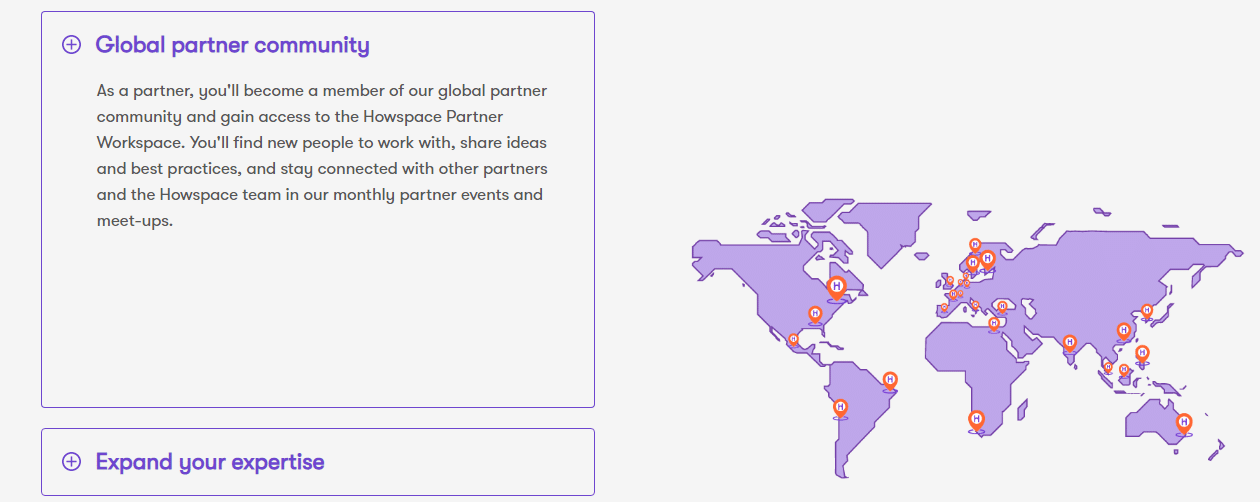
Looking for another way to foster partner communication, in addition to one-on-ones? Start a community where your partners can interact with your brand and other partners, and attend virtual events you host. This will strengthen their skills and keep them in the loop. Howspace offers one such community for their partners.
6. Track your progress towards partnership goals
Set and track KPIs using the SMART method. SMART metrics are specific, measurable, attainable, relevant, and time-bound.
You should have overarching goals for the entire B2B partner program. But you should also set individualized goals for each partner relationship.
Your needs, and the type of B2B partnership, will determine the right goals for your business growth.
Below are five examples of goals you could set:
- Increase monthly, quarterly, or annual revenue by X%
- Increase monthly, quarterly, or annual revenue generated within a given vertical by X%
- Acquire at least X new customers monthly, quarterly, or annually
- Acquire at least X new customers in a particular geographic radius monthly, quarterly, or annually
- Grow your customer base by X% monthly, quarterly, or annually
7. Manage your B2B partner program with PRM software
PRM software (partner relationship management software) makes recruiting, training, and managing partner relationships easy. It streamlines all of the tasks associated with your B2B partnership strategy, and integrates with your existing processes and tools.
Some of the tasks PRM software can assist you with include:
- Discovering partners
- Creating a partner portal
- Onboarding partners
- Communicating with partners
- Sharing resources and branded sales assets with partners
- Tracking and measuring the success of each partnership in real time
- Rewarding your partners in a timely manner
- Automation of routine, partnership-related tasks and processes
- Safeguarding the integrity of your brand and preventing fraud
Referral Rock’s PRM software platform has the flexibility to manage and track all types of B2B partner programs.
Our robust platform automates every step of the process, so it’s easy for your business to scale.
Learn more or schedule a demo today.
Wrapping up
Partner programs are a hidden gem for B2B businesses to scale faster and build mutual relationships that benefit them in the long term.
If you haven’t implemented a B2B partner program, you could be missing out on increased revenue and a larger customer base.
However, it’s easy to build a successful partner program using the best practices we shared – and the right software to run it all.

